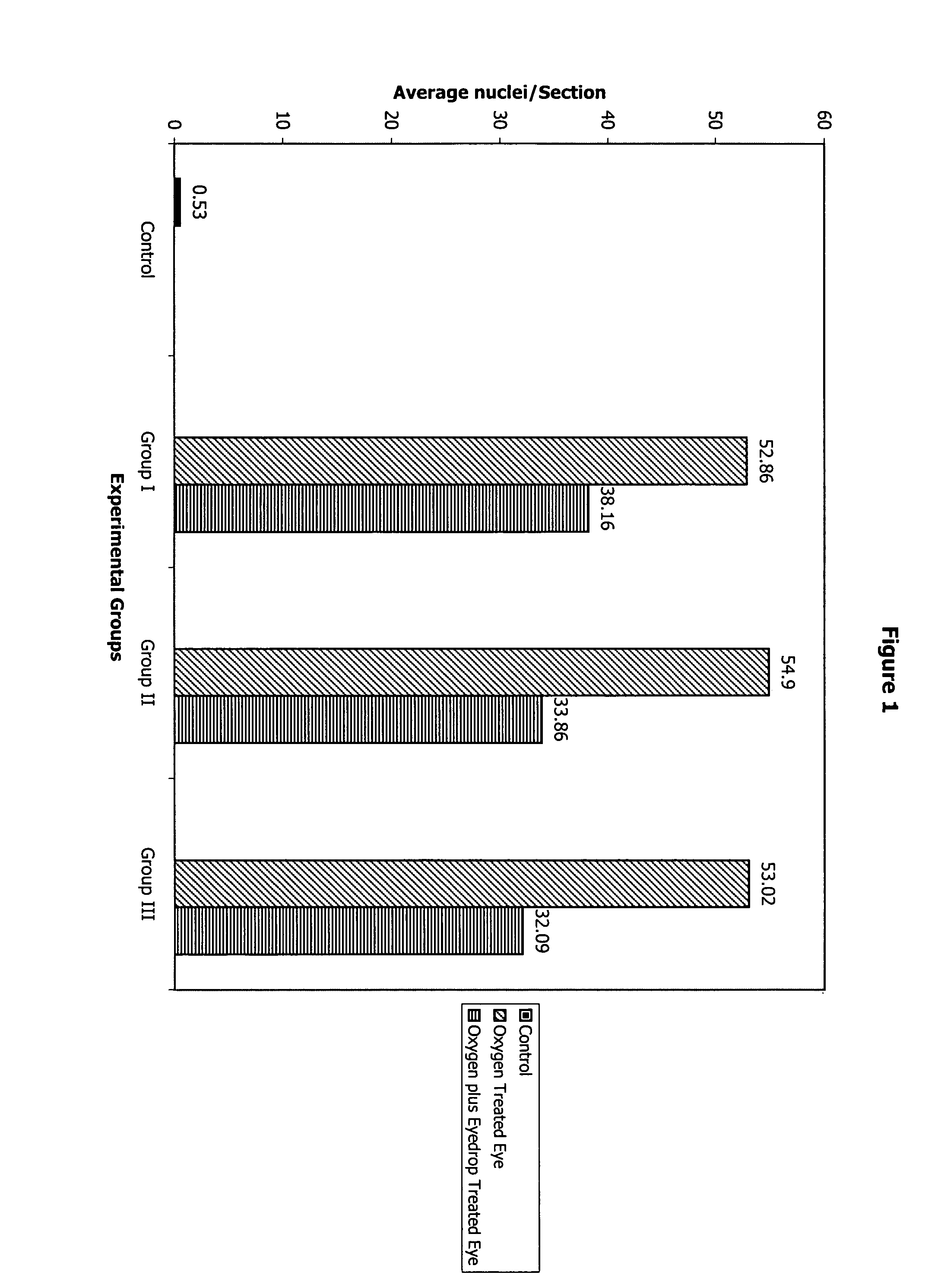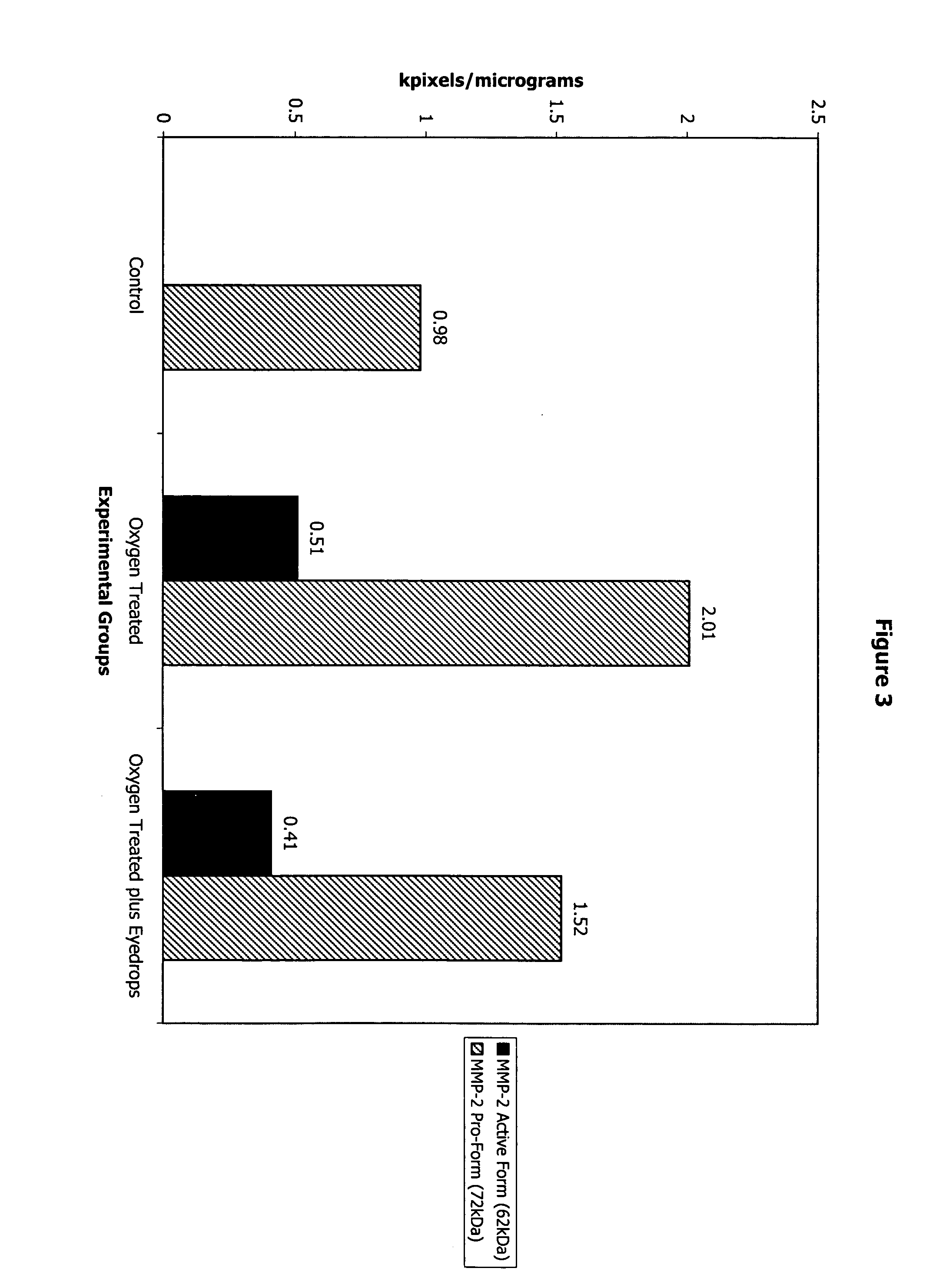Methods and compositions for treating and inhibiting retinal neovascularization
- Summary
- Abstract
- Description
- Claims
- Application Information
AI Technical Summary
Benefits of technology
Problems solved by technology
Method used
Image
Examples
example 1
Preparation of Compositions Containing a Batimastat Compound
[0071]Various formulations of the compositions of the present invention were compounded, and are listed in the following table.
[0072]
Formulation 1Formulation 2Formulation 3Compound(w / w %)(w / w %)(w / w %)HPMC2.5Batimastat0.30.30.3Mannitol1.0Sorbitol1.5Glycerin1.0Poloxamer 4070.50.050.05Polycarbophil1.250.85NaCl0.60.2Sodium Citrate0.350.35DihydrateBenzalkonium0.008Chloride (BAK)EDTA0.10.1Waterq.s. to 100%q.s. to 100%q.s. to 100%NaOHq.s. to pH 6q.s. to pH 6q.s. to pH 6
[0073]The physical and chemical characteristics of the compositions of the invention may be modified or optimized according to the skill in the art. Thus, pH, osmotic pressure, viscosity, and the content of various additional components may be chosen from any appropriate range known or modified from the examples given here. The methods for preparing and selecting exemplary formulations containing polymeric suspension agents are described in U.S. Pat. Nos. 5,188,826...
example 2
Topical Ophthalmic Administration of a Composition Containing Batimastat in Mice
[0079]A newborn mouse animal model of neovascularization conditions and diseases such as age-related macular degeneration, diabetic retinopathy, and oxygen-induced blindness demonstrates the utility and surprisingly advantageous topical, ophthalmic administration of batimastat.
[0080]Newborn mice on postnatal day 7 are kept in high oxygen (75 percent) from day 7 to 11, and then are brought to normal room air on day 12. A relative hyperoxia results, and retinal neovascularization is seen in 100 percent of the exposed animals by day 17. Some of the animals (n=9) initially exposed to the oxygen cycle receive Formulation 1 eyedrops four times a day in the right eye on days 14–17 (four days) (Group I). Some animals (n=9) receive the same eyedrops, administered similarly, on days 13–17. In another group of animals (n=9) (Group III), the eyedrops are instilled in the right eye and normal saline is instilled in t...
example 3
Topical Ophthalmic Administration of a Composition Containing Batimastat in Rabbits
[0086]A study in rabbits will examine the 14C activity in ocular tissues and blood plasma following administration of a topical ophthalmic composition containing 0.3 percent labeled batimastat in the DuraSite® delivery vehicle. The ocular tissues to be examined are the aqueous humor, cornea, iris and ciliary body, vitreous humor, retina and choroid, and the sclera. The study will proceed in three step-wise phases: phase 1 will examine 14C activity at 20 minutes, 40 minutes, 1 hour and 2 hours post-administration, phase 2 will examine 14C activity at 3 and 4 hours post-administration, and phase 3 will examine 14C activity at 6 and 8 hours post-administration. Initially, 6 rabbits (12 eyes) will be examined at each time point. If any phase of the study is not executed, the rabbits allocated to that phase may be reassigned to other time points to better estimate bioavailability and pharmacokinetics. Nor ...
PUM
| Property | Measurement | Unit |
|---|---|---|
| Fraction | aaaaa | aaaaa |
| Percent by mass | aaaaa | aaaaa |
| Fraction | aaaaa | aaaaa |
Abstract
Description
Claims
Application Information
 Login to View More
Login to View More - R&D
- Intellectual Property
- Life Sciences
- Materials
- Tech Scout
- Unparalleled Data Quality
- Higher Quality Content
- 60% Fewer Hallucinations
Browse by: Latest US Patents, China's latest patents, Technical Efficacy Thesaurus, Application Domain, Technology Topic, Popular Technical Reports.
© 2025 PatSnap. All rights reserved.Legal|Privacy policy|Modern Slavery Act Transparency Statement|Sitemap|About US| Contact US: help@patsnap.com



